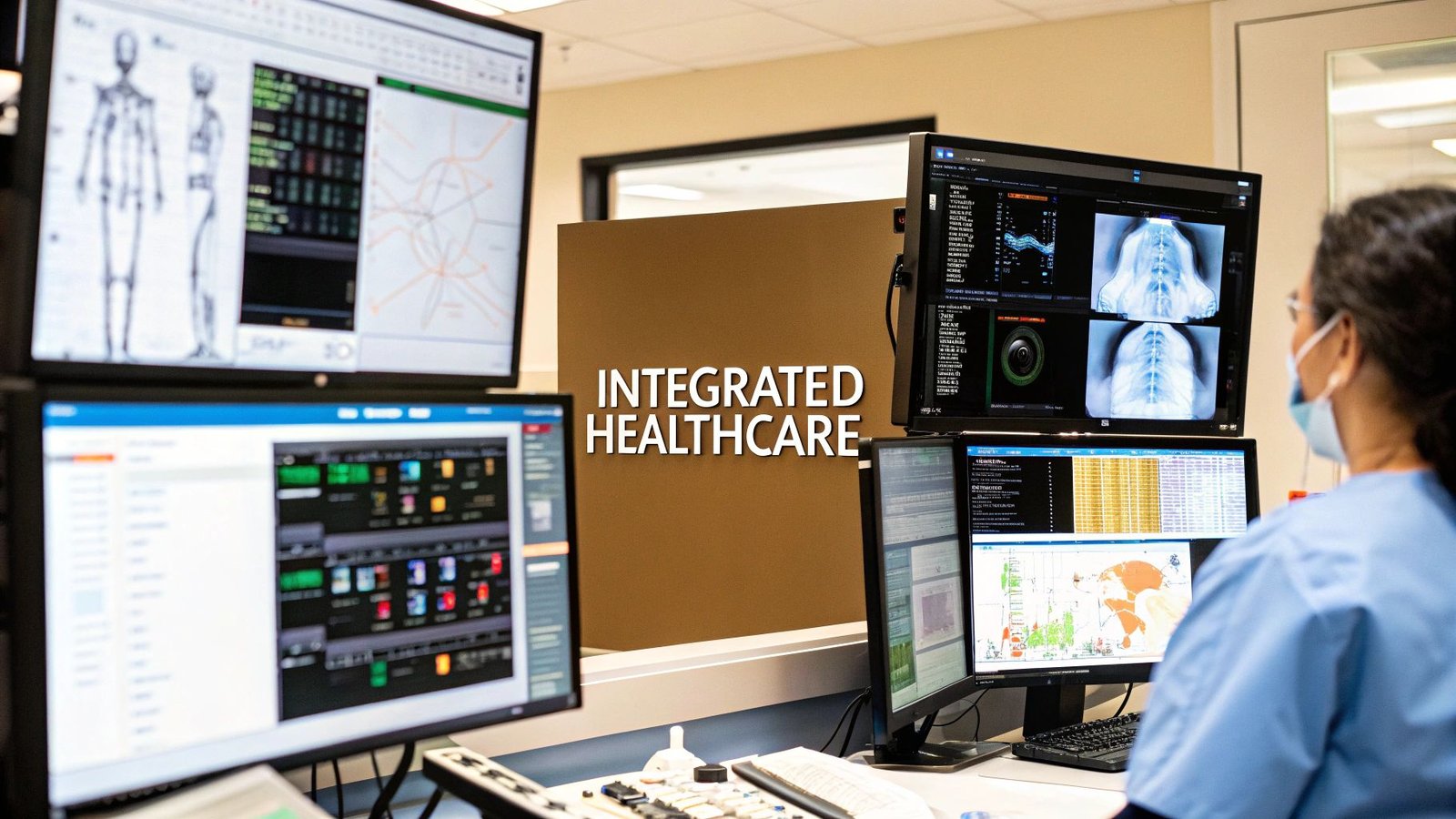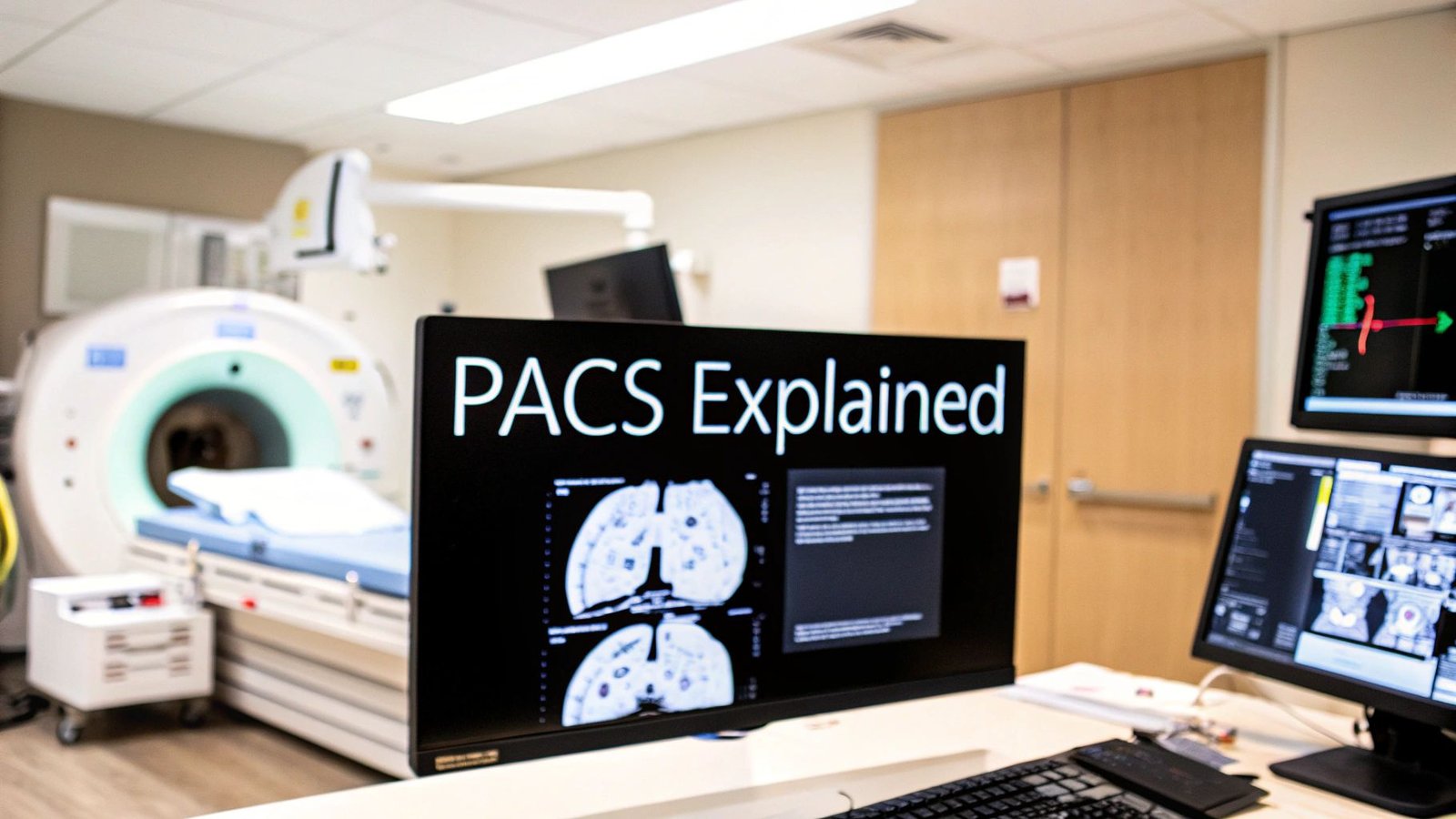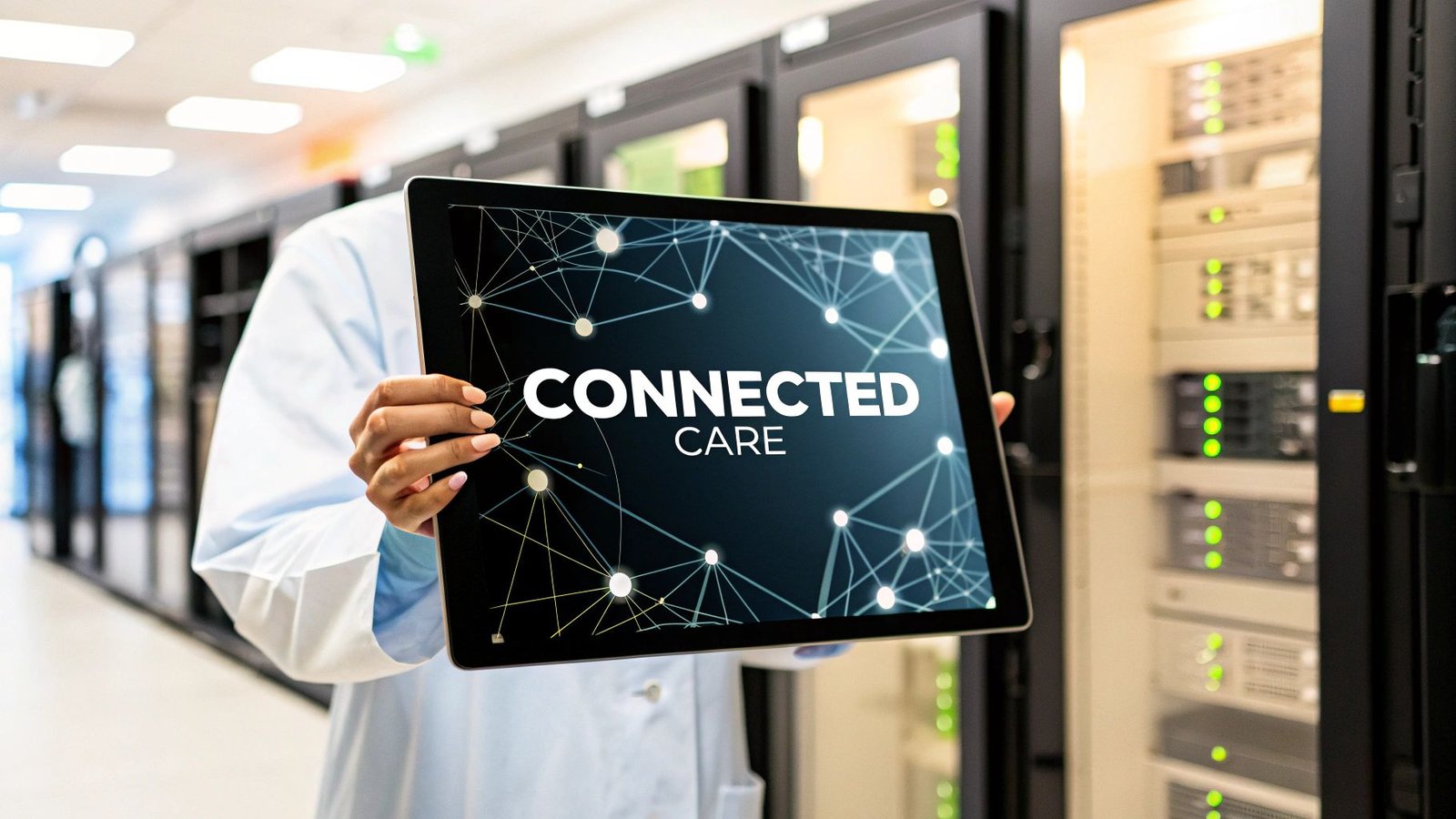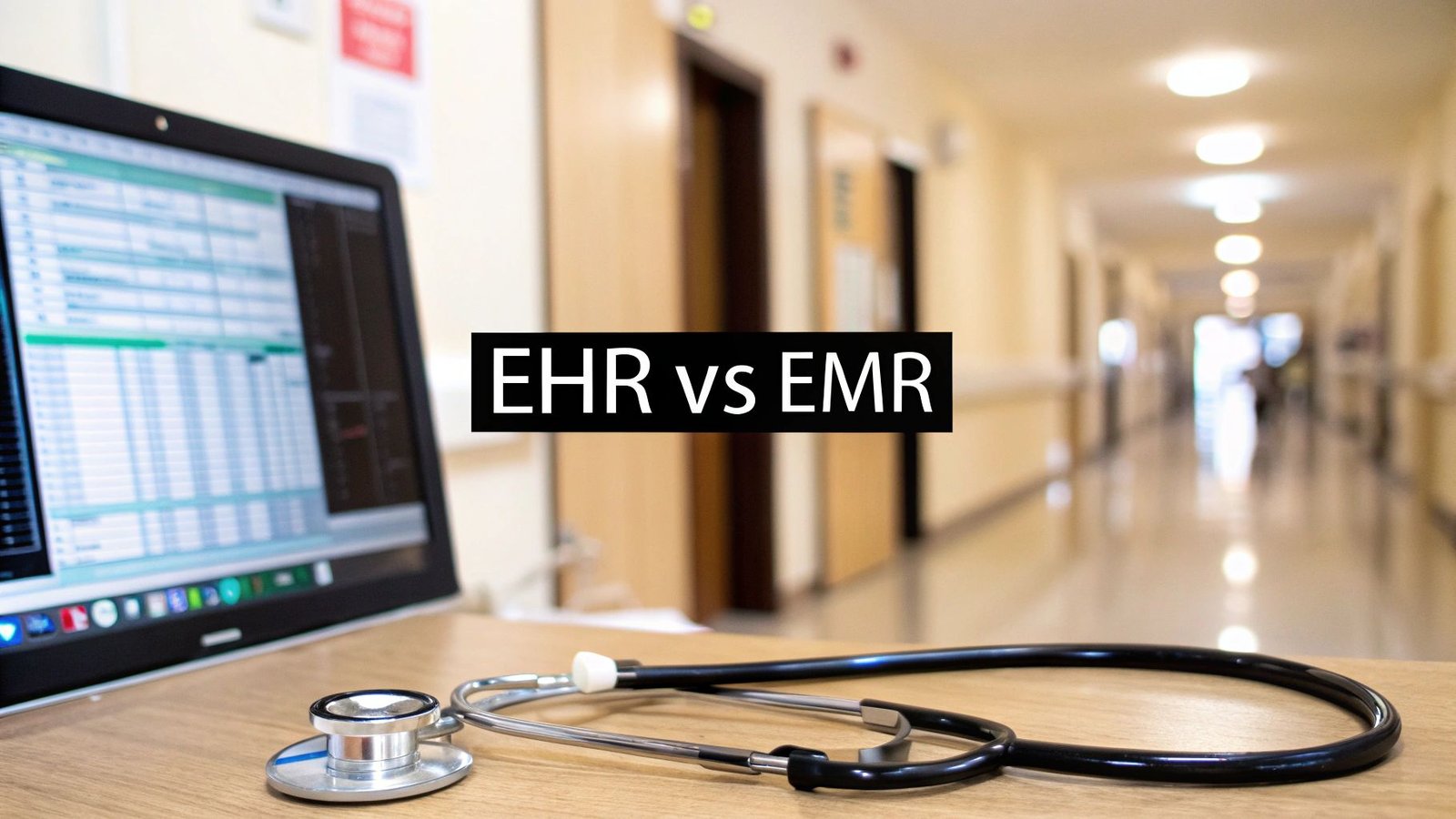The Evolution of Healthcare Data: From Silos to Seamless Systems
Historically, patient medical records were kept in physical files, creating information silos. This fragmented approach made it difficult to access vital patient data and hindered effective care coordination. Digitizing these records was a significant step forward, but it also introduced new challenges. Early electronic systems often operated in isolation, mirroring the limitations of their paper-based predecessors. Crucial information remained trapped within individual departments or facilities.
Think of it like separate islands in an archipelago, each holding pieces of a patient's health story. This lack of connectivity made it difficult to get a complete picture of a patient's health.
Bridging the Data Divide
The need for data integration in healthcare became increasingly clear. Consider a patient visiting a specialist who needs access to their primary care physician's notes. Without integrated systems, obtaining these records could involve time-consuming phone calls, faxes, or even physical mail. These delays could significantly impact diagnosis and treatment.
This demand for interoperability spurred innovation in healthcare IT, leading to the development of standards and technologies aimed at connecting these disparate systems. The goal was to create a more fluid and connected healthcare ecosystem where data could be shared easily and securely.
Market Growth and Driving Forces
The healthcare data integration market has seen substantial growth. In 2024, the market was valued at approximately $2.4 billion. By the end of 2025, it's projected to reach $2.84 billion, demonstrating an 18.4% CAGR. Several factors are driving this growth:
- Increased use of Clinical Decision Support Systems (CDSSs)
- The shift to value-based care
- The growing importance of data-driven decisions
By 2029, the market is expected to reach $5.52 billion. This continued expansion highlights the crucial role data integration plays in modernizing healthcare and improving patient outcomes. For more detailed information, see the Healthcare Data Integration Global Market Report.
The Role of Regulation and Legacy Systems
Regulations like HIPAA and HITECH have played a significant role in shaping the evolution of healthcare data integration. These regulations mandated the protection of Patient Health Information (PHI), influencing how data integration was approached. HIPAA, for instance, established stringent security requirements, adding complexity to integration projects.
Connecting systems wasn't enough; they also had to meet strict privacy and security standards. Furthermore, many healthcare organizations still rely on legacy systems, some dating back to the 1990s. These older systems often lack interoperability features, presenting substantial challenges for integration teams.
The Rise of Interoperability and Looking Ahead
The journey toward seamless data integration has been a gradual but important one. From basic data exchange to the emergence of standards like HL7 and FHIR, healthcare has made significant progress in connecting its data ecosystem. This progress allows for more efficient data sharing, streamlines workflows, and ultimately improves patient outcomes.
Looking ahead, efficient data management is critical. For more insights, see this article on KYC data management. The increasing focus on interoperability is paving the way for a future where data flows seamlessly across the healthcare continuum, empowering providers with the information they need to deliver the best possible care.
The Hidden ROI: Measuring Data Integration's True Impact

Beyond the technical details, the real power of data integration in healthcare lies in its measurable benefits. These advantages extend beyond simple connectivity to significantly impact both patient care and an organization's financial health. This translates to better clinical decisions, more streamlined operations, and ultimately, improved patient outcomes.
Quantifying the Benefits of Integration
Data integration equips clinicians with a comprehensive overview of patient information. This holistic view can lead to a substantial decrease in diagnostic errors. Some leading institutions have reported a 30% decrease in such errors after implementing comprehensive data integration systems.
This improvement comes from having all necessary patient data readily available, eliminating the need to gather fragmented information from various sources. This improved access results in faster, more accurate diagnoses and more effective treatment plans.
In addition, integrated systems have been successful in reducing medication errors. By offering clinicians real-time access to patient medication histories, allergies, and potential drug interactions, these systems help prevent adverse drug events and enhance patient safety. Data integration further streamlines workflows by reducing redundant tests. With a unified view of past tests and results, clinicians can avoid unnecessary repetitions, conserving both time and resources.
From Cost Savings to Patient Satisfaction
The positive effects of data integration reach beyond clinical advancements to include noticeable financial gains. By optimizing operations and minimizing inefficiencies, hospitals can achieve substantial reductions in operational costs. The elimination of redundant tests, for example, directly results in cost savings. Improved care coordination can also lower hospital readmission rates, yielding further financial advantages.
The return on investment of data integration isn't limited to financial metrics. Enhanced patient satisfaction is another vital benefit. When clinicians can dedicate more time to patient interaction rather than administrative tasks or information retrieval, the patient experience naturally improves.
This increased interaction builds trust and stronger patient-provider relationships, ultimately leading to higher satisfaction scores. This is particularly important in today's value-based care landscape, where patient experience is a crucial performance metric.
The increasing focus on value-based care and the demand for comprehensive patient data overviews have made healthcare data integration a global priority. One example is the Indonesian government’s launch of SATUSEHAT, a national data integration platform, in August 2022. Globally, the healthcare data integration market was valued at $1.05 billion in 2022 and is projected to grow at a CAGR of 14.5% through 2030, reaching $3.11 billion. This growth is primarily driven by the increasing adoption of Electronic Health Records (EHRs) and other IT systems, along with the growing demand for value-based healthcare delivery. Integrated data provides healthcare professionals with a more complete understanding of patient health, improving diagnosis, treatment planning, and care coordination. As health systems worldwide aim to improve information access and support value-driven initiatives, data integration is increasingly recognized as essential for enhancing quality, efficiency, and patient engagement across all major healthcare markets. You can find more detailed statistics here.
Communicating the Value of Integration
Showing the ROI of data integration requires a solid understanding of the metrics that are most relevant to your organization. This means pinpointing key performance indicators (KPIs) and monitoring their development over time. These KPIs might include:
- Reduction in medication errors
- Decrease in diagnostic errors
- Improvement in patient satisfaction scores
- Decrease in hospital readmissions
- Cost savings from fewer tests
By monitoring these KPIs, healthcare organizations can effectively demonstrate the tangible advantages of data integration. Communicating these results to stakeholders is essential for garnering support and securing approval for future integration projects. This communication should highlight the positive effects on patient care, operational efficiency, and financial performance. By showcasing the real value of integrated data, healthcare organizations can ensure ongoing investment and innovation in this critical area. This ensures data integration is seen not just as a technical process, but as a strategic investment in the future of healthcare.
Before presenting the benefits, it's important to understand the impact of data integration. The following table highlights the key advantages for various stakeholders:
Key Benefits of Data Integration in Healthcare
| Stakeholder | Primary Benefits | Measurable Outcomes |
|---|---|---|
| Clinicians | Improved diagnostic accuracy, reduced medication errors, streamlined workflows | Fewer diagnostic errors, decreased adverse drug events, increased efficiency |
| Patients | Enhanced safety, better treatment outcomes, improved communication with providers | Reduced medical errors, improved health outcomes, higher satisfaction scores |
| Healthcare Organizations | Lower operational costs, improved care coordination, increased efficiency | Reduced costs associated with redundant tests and readmissions, streamlined processes |
| Payers | Better management of population health, improved quality of care, reduced healthcare spending | Lower healthcare costs, improved quality metrics |
This table illustrates how data integration creates a positive ripple effect across the healthcare ecosystem, benefiting all involved. By facilitating better decision-making, improving efficiency, and ultimately leading to better patient care, data integration is transforming the delivery of healthcare services.
Breaking Down Walls: Tackling Healthcare's Integration Barriers
Connecting healthcare systems is a complex undertaking, presenting unique challenges. It's not simply about linking systems; it's about building a functional, secure, and interoperable ecosystem with seamless data flow. This section explores the technical obstacles that make healthcare data integration particularly challenging.
Technical Debt and System Variety
One of the biggest hurdles is the wide variety of systems involved. Hospitals and clinics often rely on a mix of technologies, some decades old, each with its own data formats and communication protocols. Integrating these disparate systems is a significant undertaking, often requiring extensive effort. This accumulated technical debt makes integration projects costly and time-consuming.
For example, a hospital might have a modern Electronic Health Record (EHR) system, but still needs to integrate data from older lab systems, radiology equipment, and legacy billing software. Each connection requires specialized expertise and custom solutions, increasing the integration project's overall complexity.
Privacy, Security, and Healthcare Regulations
Healthcare data is inherently sensitive. Protecting patient privacy and ensuring data security are paramount. Regulations like the Health Insurance Portability and Accountability Act (HIPAA) mandate strict controls over how patient information is accessed, stored, and transmitted, adding another layer of complexity to integration projects. Solutions must not only connect systems but also adhere to rigorous security standards.
This means simple data transfers are insufficient. Robust encryption, access control mechanisms, and audit trails are essential for safeguarding patient information. These requirements often necessitate specialized integration tools and expertise, increasing project costs and timelines.
Standards: FHIR and HL7 as Building Blocks
Industry standards like FHIR (Fast Healthcare Interoperability Resources) and HL7 (Health Level Seven) are helping address interoperability challenges. These standards provide a common language for healthcare systems to communicate, simplifying integration. However, while representing significant progress, they are not a complete solution.
These standards are like universal electrical outlets. While enabling various devices to plug in, they don't guarantee seamless operation. Similar challenges exist with FHIR and HL7. Many legacy systems still require custom interfaces to connect with these standard-based platforms.
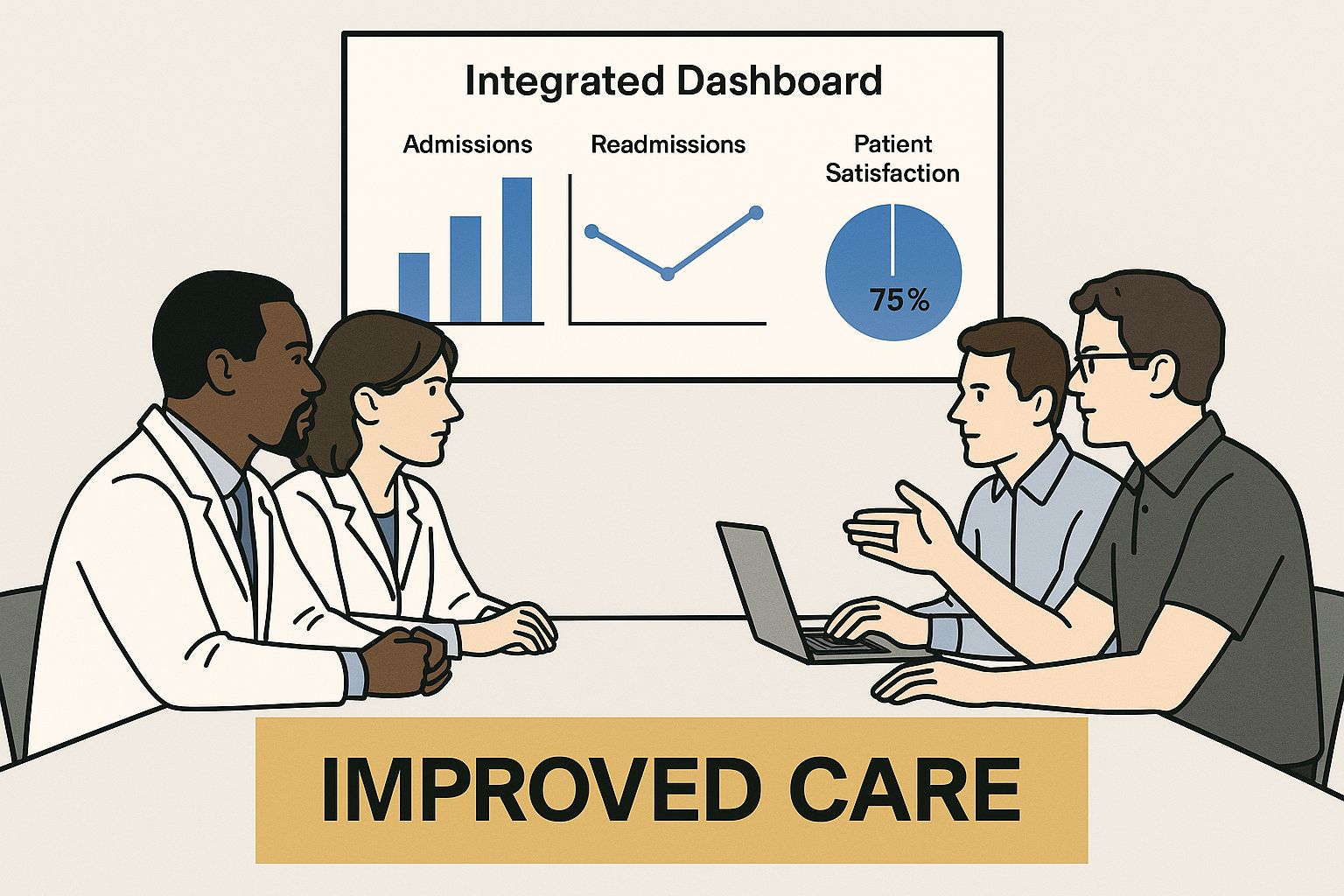
The image above depicts a collaborative healthcare meeting, with doctors and IT specialists reviewing an integrated dashboard display. The "Improved Care" text highlights the ultimate goal of these integration efforts.
The image showcases integrated data's potential to transform clinical workflows, empowering clinicians with the information they need for better care. A unified view of patient data improves decision-making and contributes to improved patient outcomes. The collaborative nature of the scene highlights the importance of cross-functional teamwork in successful data integration projects.
Semantic Interoperability: Ensuring Data Understanding
Connecting systems is one thing; achieving true semantic interoperability is another. This means data not only flows between systems but is also understood and interpreted correctly. Different systems might use different codes for the same diagnosis. True interoperability requires resolving these differences to preserve data meaning across systems.
This remains a significant challenge, even in sophisticated health systems. According to SNS Insider, the healthcare IT integration market is projected to reach $12.97 billion by 2032, growing at a CAGR of 12.69%. This growth is fueled by the increasing need for seamless data exchange and integrated solutions. More detailed statistics are available here.
The following table provides a summary of common technical challenges in healthcare data integration:
Common Technical Challenges in Healthcare Data Integration
| Challenge Category | Impact Level | Common Solutions | Implementation Complexity |
|---|---|---|---|
| Technical Debt & System Variety | High | System upgrades, Interface engines, Data standardization | High |
| Privacy and Security | High | Encryption, Access controls, Audit trails | Medium |
| Lack of Interoperability Standards | Medium | FHIR, HL7 implementations | Medium |
| Semantic Interoperability | Medium | Data mapping, Terminology services | High |
This table compares major technical challenges in healthcare data integration implementation, their relative impact, and potential solution approaches. As shown, addressing technical debt and ensuring privacy and security are high-impact areas requiring complex solutions. While standards like FHIR and HL7 offer solutions, achieving true semantic interoperability remains a complex challenge.
Strategic Planning for Integration Success
Successful data integration requires strategic planning, cross-functional collaboration, and realistic expectations. Organizations need to assess their current data landscape, define clear integration goals, and secure buy-in from all stakeholders, including clinicians, IT specialists, and administrators.
Choosing the right integration technology and establishing robust governance processes to ensure data quality and compliance is also crucial. By approaching healthcare data integration with a clear strategy and a collaborative mindset, organizations can overcome these complex challenges and unlock the full potential of their data.
Building Your Integration Blueprint: From Planning to Execution
Moving from the theoretical stage to actual implementation demands a well-structured approach. This section provides a step-by-step guide to successful healthcare data integration, utilizing proven strategies from real-world projects. We’ll examine the crucial initial stages, from evaluating your current data environment to obtaining leadership buy-in and assembling a proficient team.
Assessing Your Current Data Landscape
The foundation of any successful data integration project is a comprehensive evaluation of your existing data landscape. This involves cataloging all data sources, understanding their formats, identifying any data quality concerns, and mapping the current data flow (or lack thereof) within your organization. This assessment creates a baseline for planning and allows you to prioritize integration efforts effectively.
For instance, consider a hospital system with numerous clinics, each operating with a different Electronic Health Record (EHR) system. A comprehensive assessment would inventory these systems, document their data formats and interoperability features, and analyze current data exchange processes between the clinics and the main hospital.
Securing Executive Sponsorship and Building Your Team
Data integration initiatives are complex endeavors requiring high-level support. Securing executive sponsorship is essential to obtain necessary resources and ensure organizational alignment. Building a capable team is equally critical. This team needs individuals with expertise in:
- Data architecture
- Data governance
- Healthcare IT
- Clinical operations
Including representatives from various departments ensures the integrated system meets everyone's needs. This cross-functional team will oversee planning, execution, and monitoring of the integration project.
Selecting the Right Integration Technology
Choosing the right integration technology is paramount to project success. There's no universal solution; the optimal approach varies depending on several factors:
- Your specific integration needs
- Your budget
- Your existing IT infrastructure
Options vary from simple point-to-point connections for basic integrations to robust Enterprise Service Bus (ESB) platforms for complex scenarios. Modern API-based platforms offer flexibility and scalability, making them increasingly popular for healthcare data integration.
Consider factors such as data volume, the speed of data generation (data velocity), and the need for real-time integration when making your technology choices. Evaluate potential vendors based on their healthcare experience, security track record, and ability to support your long-term integration strategy.
Establishing Data Governance Frameworks
Maintaining data quality and compliance throughout the integration requires strong data governance. This involves establishing clear policies and procedures for data management, encompassing data validation, data cleansing, and data security. A robust governance framework ensures the integrated data is:
- Accurate
- Consistent
- Secure
This framework provides the necessary structure for data quality management and ensures ongoing compliance with relevant regulations, such as HIPAA. Clear data ownership, access control policies, and data retention guidelines are essential components of effective data governance.
Architectural Approaches: From Point-to-Point to API Platforms
Integration architecture can range from simple point-to-point connections between two systems to more sophisticated approaches like API-driven platforms. Point-to-point connections work for limited integrations but can become difficult to manage as the number of connected systems increases.
API-based integration offers greater flexibility and scalability, enabling seamless connections with a wider array of systems. This architectural approach is more adaptable to the dynamic needs of modern healthcare settings.
Learning From Successful Implementations
Many healthcare organizations have successfully implemented data integration. Learning from their experiences provides invaluable insights. Best practices include:
- Starting with a pilot project to test the chosen technology and refine processes
- Establishing clear metrics to measure integration success
- Maintaining open communication with stakeholders throughout the project lifecycle
These approaches, along with thorough planning and collaboration, help implement effective and efficient data integration solutions within your organization.
Fueling Value-Based Care Through Connected Data Systems

As healthcare transitions from fee-for-service to value-based care, the role of data integration in healthcare becomes increasingly critical. This shift requires a new understanding of healthcare economics, one built upon the foundation of interconnected data systems. This section explores why data integration is so essential for the success of value-based care.
Measuring Quality and Tracking Outcomes
Value-based care programs depend on reliable methods for measuring the quality of care and tracking patient outcomes. Data integration makes this possible by combining information from different sources, creating a complete picture of patient health. This combined data allows providers to measure key quality indicators and monitor patient progress.
Consider a patient with diabetes who receives care from multiple providers. With integrated systems, data from primary care physicians, specialists, labs, and pharmacies can be consolidated to track blood glucose levels, medication adherence, and other important metrics. This holistic view enables better monitoring and leads to improved patient outcomes.
Cost Analysis and Bundled Payments
Data integration is also vital for the cost analysis required in value-based care. By linking financial and clinical data, organizations can gain a more accurate understanding of the true cost of care for specific patient groups and pinpoint areas for cost reduction. This is especially important for bundled payment models.
Bundled payments involve a single payment for a defined episode of care, like a knee replacement. Data integration enables the tracking of all associated costs – from pre-operative appointments to post-operative rehabilitation. This comprehensive overview helps manage costs and supports the transition to value-based reimbursement.
Identifying High-Risk Patients and Coordinating Care
Integrated data allows healthcare organizations to identify high-risk patients who would benefit from proactive interventions. By analyzing data from various sources, predictive models can pinpoint patients at risk of developing chronic conditions or experiencing adverse events. Early identification allows for timely interventions, potentially preventing costly hospitalizations and enhancing patient well-being.
Moreover, data integration improves care coordination across different healthcare settings. When information flows seamlessly between hospitals, clinics, and other providers, everyone involved in a patient's care has access to the same current information. This minimizes the risk of medical errors and improves the overall quality of care.
Population Health Management and ROI
Data integration is essential for population health management, a key aspect of value-based care. By analyzing data from an entire population, organizations can identify trends, evaluate the effectiveness of public health initiatives, and allocate resources more effectively.
For example, an integrated system might reveal a higher prevalence of a particular chronic condition within a specific demographic. This information allows for targeted interventions and preventative care programs focused on that group.
Many organizations have successfully measured the ROI of their data integration efforts within value-based care. These quantifiable benefits include reduced hospital readmissions, fewer emergency room visits, and higher patient satisfaction scores. Demonstrating a clear ROI positions data integration as a strategic investment that directly contributes to the success of value-based care, solidifying its place as a core element of a successful shift to value-based healthcare.
The Next Frontier: Emerging Trends Reshaping Healthcare Data
Data integration in healthcare is a dynamic and ever-changing field. This section explores emerging trends that are set to reshape how healthcare organizations connect and use information, preparing you for the future of data-driven healthcare.
The Rise of AI and Machine Learning in Data Integration
Artificial intelligence (AI) and machine learning are transforming healthcare data integration. These technologies are automating complex tasks, improving accuracy, and opening up new possibilities for data analysis. For example, AI algorithms can automate data mapping, a process traditionally prone to errors and time-consuming. This automation frees up valuable time for IT specialists to focus on strategic initiatives.
Machine learning is also enhancing semantic understanding. By analyzing large datasets, algorithms can identify relationships and patterns within the data, leading to more accurate and meaningful insights. This improved understanding is crucial for true interoperability, where data is not just exchanged but correctly interpreted across various systems.
Real-Time Integration for Enhanced Decision-Making
The demand for real-time data integration is increasing. Real-time capabilities are crucial for clinical decision support systems and remote monitoring programs, which require immediate access to current patient information. This access empowers clinicians with up-to-date data, enabling faster, more informed decisions that directly impact patient care.
For instance, in remote patient monitoring, real-time data integration can alert clinicians to significant changes in a patient's vital signs, allowing for immediate intervention. This rapid response can prevent adverse events and improve patient outcomes. Using HIPAA compliant transcription services is also vital for maintaining data security. For more information on HIPAA compliance: HIPAA compliant transcription.
FHIR: From Standard to Practical Implementation
FHIR (Fast Healthcare Interoperability Resources) is moving from a promising standard to practical implementation. Healthcare organizations are increasingly adopting FHIR-based APIs for data exchange, facilitating smoother integration between systems. This adoption streamlines the integration process, making it easier to connect different technologies and share data securely.
The transition to FHIR simplifies developing interoperable healthcare applications and promotes data sharing across the healthcare ecosystem. This broader adoption accelerates progress toward a truly connected healthcare system.
Blockchain for Secure Health Information Exchange
Blockchain technology, known for its security and transparency, is being explored for secure health information exchange. Blockchain can create a tamper-proof record of patient data, enhancing trust and accountability in data sharing. This enhanced security can reduce data breaches and improve patient privacy.
While still in its early stages, blockchain's potential in healthcare data integration is significant. As the technology matures, it could become a key component of secure and efficient health information exchange.
Integrating Social Determinants of Health Data
Healthcare data integration is expanding to include data related to social determinants of health (SDOH). Factors like socioeconomic status, access to transportation, and environmental conditions significantly influence health outcomes. Integrating SDOH data with clinical data provides a more holistic view of patient health.
This comprehensive understanding of patient needs allows for more personalized and effective interventions. By considering SDOH factors, healthcare providers can better address the root causes of health disparities and improve overall population health.
Preparing for the Future of Healthcare Data Integration
These emerging trends represent a significant shift in healthcare data integration. By understanding and adopting these developments, healthcare organizations can position themselves for success in a data-driven future. This proactive approach will enable organizations to improve patient care, increase operational efficiency, and achieve the goal of a truly connected healthcare ecosystem.
Ready to use the power of AI in your medical imaging solutions? Contact PYCAD today to explore how our expertise can help you achieve your goals. Learn more at PYCAD.

